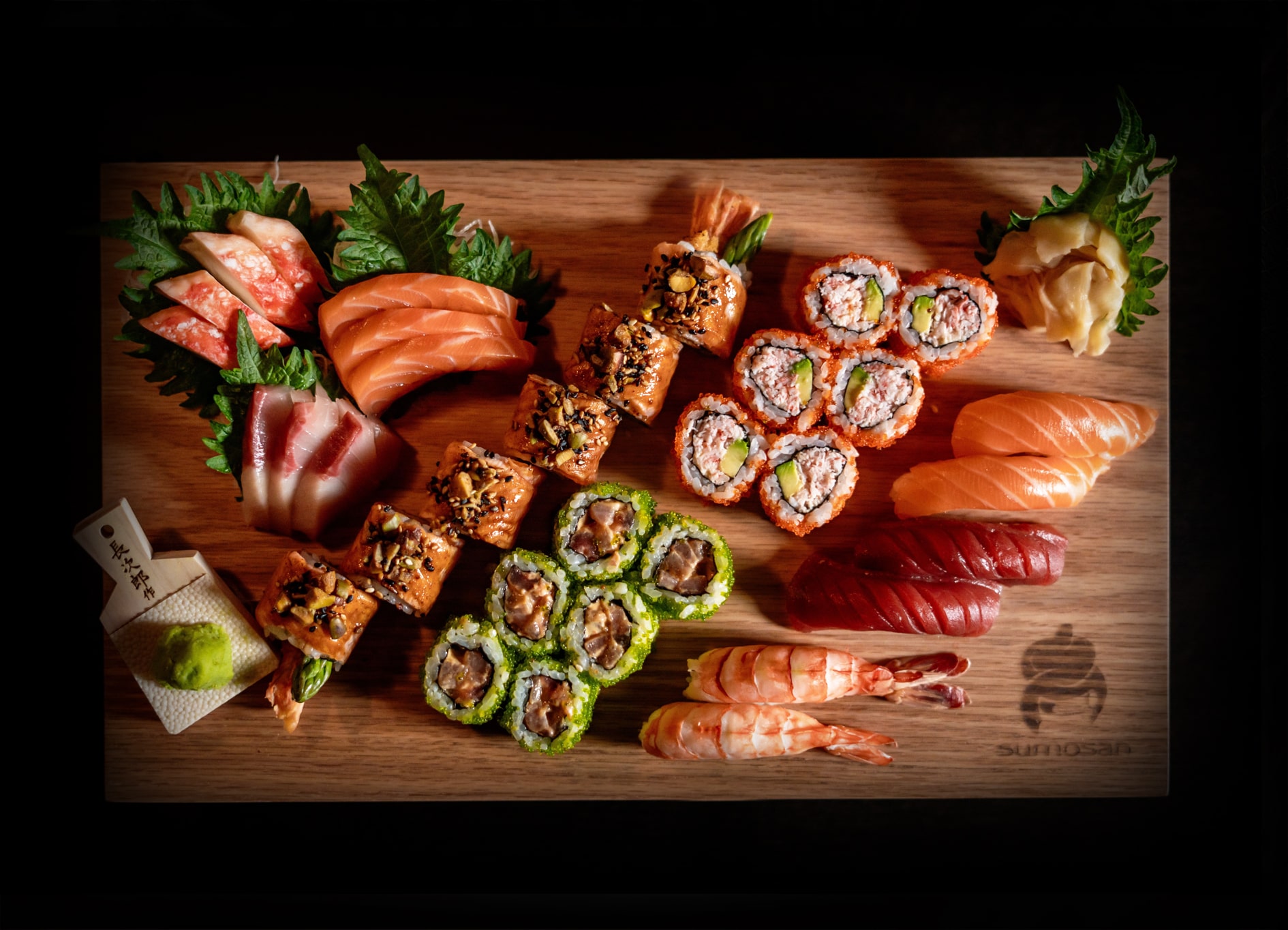Sushi: A Culinary Journey Through Time and Taste
Related Articles
- Cooking With Exotic Spices: A Guide To Using Harissa, Gochujang, And Ras El Hanout
- Paella: A Spanish Symphony Of Flavors
- Exploring Brazilian Churrasco: Mastering Grilling Techniques For Perfect Meat
- A Bowlful Of History And Flavor: Exploring The World Of Ramen
- A Culinary Journey: Mastering The Art Of Paella
Introduction
Join us as we explore Sushi: A Culinary Journey Through Time and Taste, packed with exciting updates
Sushi: A Culinary Journey Through Time and Taste

Sushi, the iconic Japanese dish of vinegared rice topped with fresh seafood, vegetables, and other ingredients, has become a global culinary phenomenon. From its humble beginnings as a method of preserving fish to its modern-day status as a sophisticated and artistic cuisine, sushi’s journey is a fascinating testament to the ingenuity and adaptability of Japanese culinary traditions.
A Brief History of Sushi
The origins of sushi can be traced back to Southeast Asia, where a method of preserving fish called "nare-sushi" emerged around the 7th century. This process involved fermenting fish with salt and rice, allowing the lactic acid produced by the fermentation to preserve the fish. The rice itself was discarded, leaving only the fermented fish for consumption.
"Narezushi" evolved over time, and by the 17th century, the Japanese began using vinegar to accelerate the fermentation process. This led to the development of "nigiri-zushi", which involved using a small amount of vinegared rice as a base for the fish, instead of discarding it. This innovation paved the way for the modern sushi we know today.
"Nigiri-zushi", as the name suggests, refers to the method of hand-pressing the rice into a small oval shape and topping it with various ingredients. This style of sushi became increasingly popular in the 19th century, with the rise of Edo (modern-day Tokyo) as a major culinary hub.
Sushi Beyond the Basics: Exploring Different Styles
While "nigiri-zushi" remains the most well-known style of sushi, there are numerous other variations that showcase the versatility and artistry of this cuisine. Here are a few notable examples:
1. Maki-zushi (Rolled Sushi): This style of sushi involves rolling vinegared rice and various fillings in a sheet of nori seaweed. The rolls are then sliced into bite-sized pieces, creating aesthetically pleasing and delicious bites.
- Hosomaki (Thin Roll): These rolls typically contain one or two simple ingredients, like cucumber, avocado, or a single type of fish.
- Futomaki (Thick Roll): These rolls feature a wider variety of ingredients, including vegetables, fish, and sometimes even eggs or pickled ginger.
- Temaki (Hand Roll): These cone-shaped rolls are filled with ingredients and then rolled into a cone shape using a sheet of nori.

2. Inarizushi (Deep-Fried Tofu Pocket Sushi): In this style, vinegared rice is filled into deep-fried tofu pockets, creating a savory and satisfying dish.
3. Chirashizushi (Scattered Sushi): This style involves spreading vinegared rice on a plate and topping it with a variety of ingredients, such as seafood, vegetables, and sometimes even egg omelets.
4. Nigirizushi (Hand-Pressed Sushi): This classic style involves hand-pressing vinegared rice into a small oval shape and topping it with a variety of ingredients, such as raw fish, cooked seafood, or vegetables.
5. Gunkan-maki (Battleship Roll): This style involves wrapping vinegared rice in a thin strip of nori and then topping it with ingredients like uni (sea urchin), ikura (salmon roe), or tobiko (flying fish roe).
The Art of Preparing Sushi Rice: A Foundation for Flavor
Sushi rice is the cornerstone of any sushi dish, and preparing it correctly is crucial to achieving the perfect balance of flavor and texture. Here’s a breakdown of the essential steps:
1. Choosing the Right Rice: Japanese short-grain rice, known as "japonica rice", is the preferred choice for sushi due to its sticky texture and ability to absorb flavor.
2. Washing and Soaking: Rinse the rice thoroughly in a fine-mesh sieve until the water runs clear. This removes excess starch and helps the rice cook evenly. Soak the rinsed rice in fresh water for 30 minutes to allow it to fully hydrate.
3. Cooking the Rice: Cook the rice in a rice cooker or on the stovetop with a 1:1.2 ratio of water to rice. The rice should be cooked until it’s soft and slightly sticky but not mushy.
4. Preparing the Sushi Rice Seasoning: This mixture, known as "sushi-zu", typically includes rice vinegar, sugar, and salt. The proportions can vary slightly, but the goal is to achieve a slightly sweet and tangy flavor that complements the other ingredients.
5. Mixing the Seasoning: Once the rice has cooled slightly, gently fold in the sushi-zu seasoning while using a rice paddle to ensure even distribution.

6. Resting the Rice: After mixing in the seasoning, allow the rice to rest for about 30 minutes to allow the flavors to meld and the rice to absorb the seasoning.
Mastering the Art of Cutting and Serving Sushi
While the preparation of sushi rice is essential, the cutting and serving techniques are equally important for ensuring a visually appealing and enjoyable dining experience.
1. Cutting Sushi:
- Maki-zushi (Rolled Sushi): Use a sharp knife to slice the rolls into even pieces, ensuring clean cuts and a consistent appearance.
- Nigirizushi (Hand-Pressed Sushi): While nigiri is typically served whole, some chefs prefer to slice it in half for easier consumption.
- Temaki (Hand Roll): Temaki is usually served whole, allowing diners to enjoy the full flavor and texture of the ingredients.
2. Serving Sushi:
- Presentation Matters: Sushi is often served on a small plate or tray, with decorative elements like wasabi, pickled ginger (gari), and soy sauce.
- Proper Etiquette: Use chopsticks to pick up sushi pieces, and dip them in soy sauce with the fish side facing down. Avoid over-dipping, as this can dilute the flavor of the fish.
- Gari (Pickled Ginger): Gari is a small piece of pickled ginger served between sushi pieces to cleanse the palate and prepare for the next bite.
Sushi Recipes: A Culinary Adventure Awaits
1. Basic Nigiri Sushi:
Ingredients:
- 1 cup cooked sushi rice
- 1 tablespoon sushi-zu seasoning
- 1 piece of fresh salmon (about 4 ounces)
- Wasabi paste
- Soy sauce
Instructions:
- Prepare the sushi rice according to the instructions above.
- Slice the salmon into thin, even pieces.
- Using damp hands, shape a small amount of sushi rice into an oval shape.
- Place a small amount of wasabi paste on top of the rice.
- Gently press a piece of salmon onto the rice.
- Serve immediately with soy sauce on the side.
2. Classic Cucumber Maki Sushi:
Ingredients:
- 1 cup cooked sushi rice
- 1 tablespoon sushi-zu seasoning
- 1 sheet of nori seaweed
- 1 cucumber, peeled and thinly sliced
- Sushi rice vinegar
Instructions:
- Prepare the sushi rice according to the instructions above.
- Lay the nori seaweed on a bamboo rolling mat (makisu).
- Spread a thin layer of sushi rice evenly over the nori, leaving a small border at the top.
- Place a row of cucumber slices along the bottom edge of the rice.
- Gently roll the sushi using the makisu, ensuring the rice is on the outside.
- Moisten the edge of the nori with sushi rice vinegar to seal the roll.
- Cut the roll into 8 even pieces using a sharp knife.
- Serve immediately.
3. Spicy Tuna Temaki Sushi:
Ingredients:
- 1 cup cooked sushi rice
- 1 tablespoon sushi-zu seasoning
- 1 sheet of nori seaweed
- 1/2 cup cooked tuna, finely chopped
- 1 tablespoon mayonnaise
- 1/2 teaspoon sriracha sauce
- 1/4 avocado, diced
- Sesame seeds (for garnish)
Instructions:
- Prepare the sushi rice according to the instructions above.
- Combine the chopped tuna, mayonnaise, and sriracha sauce in a bowl.
- Lay the nori seaweed on a flat surface.
- Place a small amount of sushi rice at the bottom of the nori, leaving a small border at the top.
- Place a dollop of the spicy tuna mixture in the center of the rice.
- Top with diced avocado.
- Gently roll the nori into a cone shape, starting from the bottom and rolling towards the top.
- Sprinkle sesame seeds on top for garnish.
- Serve immediately.
Tips for Perfecting Your Sushi Skills
1. Mastering the Rice Texture: The key to perfect sushi rice is achieving the right balance of stickiness and firmness. Overcooked rice will be too mushy, while undercooked rice will be too hard.
2. Using Fresh Ingredients: Freshness is paramount in sushi. Use high-quality seafood and vegetables to ensure the best flavor and texture.
3. Seasoning with Care: The sushi-zu seasoning plays a crucial role in balancing the flavors of the dish. Adjust the proportions of rice vinegar, sugar, and salt to your liking.
4. Cutting with Precision: Sharp knives are essential for clean cuts and a professional appearance. Use a sawing motion when cutting sushi rolls to prevent them from falling apart.
5. Practice Makes Perfect: Like any culinary skill, sushi making takes practice. Don’t be discouraged if your first attempts aren’t perfect. With time and patience, you’ll master the art of creating delicious and beautiful sushi.
Sushi: A Culinary Journey of Discovery
Sushi is more than just a dish; it’s a culinary journey of discovery. From the rich history of its origins to the intricate techniques involved in its preparation, sushi offers a unique and rewarding experience for both cooks and diners. By embracing the principles of freshness, precision, and artistry, you can create your own sushi masterpieces and share the joy of this beloved Japanese cuisine with others.
Closure
Thank you for reading! Stay with us for more insights on Sushi: A Culinary Journey Through Time and Taste.
Make sure to follow us for more exciting news and reviews.
We’d love to hear your thoughts about Sushi: A Culinary Journey Through Time and Taste—leave your comments below!
Keep visiting our website for the latest trends and reviews.






